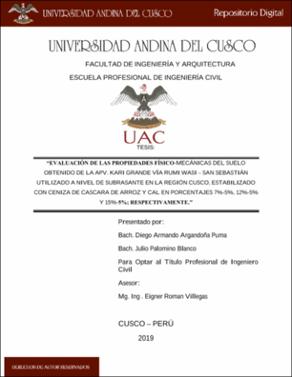| dc.contributor.advisor | Román Villegas, Eigner | |
| dc.contributor.author | Argandoña Puma, Diego Armando | |
| dc.contributor.author | Palomino Blanco, Julio | |
| dc.date.accessioned | 2020-11-26T16:50:33Z | |
| dc.date.available | 2020-11-26T16:50:33Z | |
| dc.date.issued | 2020-05-16 | |
| dc.identifier.uri | https://hdl.handle.net/20.500.12557/3487 | |
| dc.description.abstract | Los fines y objetivos de la presente investigación es evaluar y mejorar las propiedades físicomecánicas
del
material
que
se
utilizara
a
nivel
de
subrasante,
estabilizado
con
ceniza
de
cascara
de
arroz
y cal en distintos porcentajes; verificando que estos materiales cumplan con lo mínimo
establecido por la norma para ser utilizado como material de sub-rasante, para tal fin se realizó
pruebas de laboratorio, tales como: ensayos de limite líquido, limite plástico, relaciones humedaddensidad
(proctor
modificado)
y
relación
de
soporte
de
California
(CBR);
bajo
la
tutela
del
Manual
de
Ensayo
de
Materiales
(2016).
Esta investigación presenta un enfoque cuantitativo, debido a que los datos obtenidos en campo
son medidos y analizados según sea el fin de estas (se hizo una medición de las propiedades físicomecánicas
del
suelo). Así
mismo,
se
establecen
las
hipótesis
antes
de
la recolección
de datos.
La investigación se centra únicamente en muestras obtenidas de la APV. Kari Grande – Vía Rumi
Wasi – distrito de San Sebastián - Provincia Cusco. Se procedió a realizar las mezclas suelo con
ceniza de cáscara de arroz (CCA) y cal en diferentes porcentajes: 7% de CCA + 5% de CAL, 12%
de CCA + 5% de CAL y 15% de CCA + 5% de CAL; respecto al agua de mezcla. Teniendo en
cuenta que la cantidad de elementos que componen nuestra muestra son: 54 ensayos que se
realizaran en laboratorio a las muestras de suelo añadiendo ceniza de cascara de arroz y cal en
dichos porcentajes. Los resultados indican que hubo incrementos poco significativos respecto al
límite plástico, limite líquido e índice de plasticidad, también hubo disminución poco significativa
respecto a la densidad máxima del suelo. Caso contrario, fue la capacidad de soporte de los suelos,
ya que muestran una notable mejora debido a la presencia de ceniza de cascara de arroz + cal,
incremento el valor de CBR de 4.45% del estado natural del suelo arcilloso, hasta 28.09%, lo cual
representa según la categoría de Sub – Rasante, como muy buena, según el Manual de carretera –
Suelos, Geología, Geotecnia y Pavimentos, el alto porcentaje de sílice dentro de la ceniza de
cascara de arroz (86.80%), nos asegura que este material será un potencial agente estabilizador para
suelos arcillosos | es_PE |
| dc.description.abstract | The purposes and objectives of the present investigation is to evaluate and improve the physicalmechanical
properties
of
the
material
that
is
used
at
a
subgrade
level
stabilized
with
rice
husk
and
lime
ash in different percentages, verifying that these materials comply with the minimum
established by the standard to be used as a subgrade material, for this purpose laboratory tests were
performed such as: liquid liquid tests, liquid plastic, moisture-density ratios (modified tester) and
California support ratio (CBR); under the tutelage of the Materials Testing Manual (2016).
This research presents a quantitative approach, because the data obtained in the field are measured
and analyzed according to their purpose (a measurement of the physical-mechanical properties of
the soil was made). Likewise, the hypotheses are established before data collection.
The research focuses solely on samples obtained from VCT. Kari Grande - Via Rumi Wasi - San
Sebastián District - Cusco Province. The soil mixtures were made with rice husk ash (CCA) and
lime in different percentages: 7% CCA + 5% CAL, 12% CCA + 5% CAL, 15% CCA + 5% LIME;
Regarding mixing water. Taking into account that the quantity of elements that make up our sample
are: 54 tests that will be carried out in the laboratory on soil samples by adding rice husk ash and
lime in different percentages.The results indicate that there were little significant increases with
respect to the plastic limit, liquid limit and plasticity index, there was also a little significant
decrease with respect to the maximum soil density. Otherwise it was the support capacity of the
soils, since they show a notable improvement due to the presence of rice husk ash + lime, increased
the CBR value of 4.45% of the natural state of the clay soil, up to 28.09%, which represents
according to the category of Sub - Flush, as very good, according to the Road Manual - Soils,
Geology, Geotechnics and Pavements, the high percentage of silica within the rice husk ash
(86.80%), assures us that this material will be a potential stabilizing agent for clay soils. | en_US |
| dc.description.uri | Tesis | es_PE |
| dc.format | application/pdf | es_PE |
| dc.language.iso | spa | es_PE |
| dc.publisher | Universidad Andina del Cusco | es_PE |
| dc.rights | info:eu-repo/semantics/openAccess | es_PE |
| dc.rights.uri | https://creativecommons.org/licenses/by-nc-nd/2.5/pe/ | es_PE |
| dc.source | Universidad Andina del Cusco | es_PE |
| dc.source | Repositorio Institucional UAC | es_PE |
| dc.subject | Propiedades fisico-mecánicas | es_PE |
| dc.subject | Sub-rasante | es_PE |
| dc.subject | Ceniza | es_PE |
| dc.subject | Cal | es_PE |
| dc.subject | Aditivos | es_PE |
| dc.title | Evaluación de las propiedades físico-mecánicas del suelo obtenido de la APV. Kari Grande vía Rumi Wasi – San Sebastián utilizado a nivel de subrasante en la región Cusco, estabilizado con ceniza de cáscara de arroz y cal en porcentajes 7%-5%, 12%-5% y 15%-5%; respectivamente | es_PE |
| dc.type | info:eu-repo/semantics/bachelorThesis | es_PE |
| thesis.degree.name | Ingeniero Civil | es_PE |
| thesis.degree.grantor | Universidad Andina del Cusco. Facultad de Ingeniería y Arquitectura | es_PE |
| thesis.degree.level | Titulo Profesional | es_PE |
| thesis.degree.discipline | Ingeniería Civil | es_PE |


